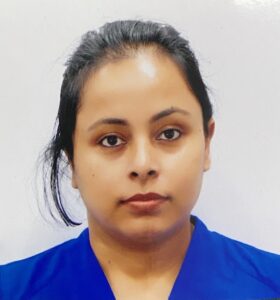Before her current position as a Genetic Purity Lab Manager in the Quality Assurance Department at Sakata Seed America, Inc., in Salinas California, Bidisha Chanda worked for the USDA and conducted research for the CucCAP watermelon team at the US Vegetable Laboratory in Charleston, South Carolina.
Introduce yourself—your background, where you are now, and your current research focus.

Bidisha Chanda
I received my BS in Agriculture and my MS in Biotechnology from Assam Agricultural University in Jorhat India. I received my PhD from the Department of Plant Pathology at the University of Kentucky in Lexington. My research was focused on identifying plant disease resistance markers (metabolites & R genes) involved in plant defense signaling and systemic acquired resistance. I completed two postdocs: one at the Department of Horticulture at Virginia Tech in Eric Beer’s lab, where I was involved in identifying xylem-genes regulating biomass development in Poplar. The second postdoc was at the US Vegetable Laboratory in Charleston, South Carolina where my research was majorly focused on identifying sources of resistance for emerging viral diseases in Cucurbits (watermelon, bottle gourd) and Solanaceous crops (tomato). Currently, I am leading the Genetic Purity Lab (Quality Assurance) as a Manager.
What is your hometown?
Kolkata, India
Who is your project leader now and who did you work with on the CucCAP project?
Sakata: Mara Trammell; USVL-USDA Charleston: Amnon Levi, Kai-Shu Ling & Chandrasekar Kousik (Shaker)
What is the focus of your work?
Plant breeding, Plant pathology, Genomics, and Host-pathogen interaction
Why did you choose to work with Cucurbits, plant breeding, plant pathology, genomics, horticulture, agricultural economics or crop production?
During my undergraduate studies in Agriculture with specialization in plant pathology, I developed great interest in understanding the biology of both pathogen(s) and the crop host(s) and the mechanisms that drive resistance or susceptibility. Both plant breeding and genomics are interdisciplinary approaches for introgression of resistance in susceptible cultivars (aiding plant pathology).
What did you hope to accomplish during your time working on the CucCAP grant?
Before moving on to Sakata, I was hoping to fine map the Prs locus in bottle gourd F2:3 population associated with PRSV-W resistance through QTL-seq and use the information to engineer disease resistant line against PRSV-W in watermelon by gene editing through CRISPR/Cas9.
Please provide a brief description of your research.
While at USDA I had the opportunity to work in a CucCAP project that aimed at screening bottlegourd (Lagenaria sinceraria) germplasm for disease resistance and other marketable traits through resequencing and association mapping. I was also involved in the US national Watermelon promotion Board in collaboration with USDA- National Institute of Food and Agriculture’s Specialty Crop Research Initiative project involving the “Molecular characterization of Ribosome-inactivating Protein in Watermelon with Resistance to Papaya Ringspot Virus”. Though my association with the National Plant Disease Recovery System (NPDRS) I had the opportunity to develop sensitive species-specific detection tools of the emerging virus in the U.S., Tomato brown rugose fruit virus (ToBRFV), and also, develop seed health assays and efficacy trials of disinfectants to prevent the mechanical transmission by deactivation of ToBRFV. Finally, I was involved in the successful development of the bioengineered infectious clone of Cucurbit leaf crumple virus (CuLCrV) for phenotyping watermelon and other vegetable crops for resistance.
What are your favorite crops, pathogens, or plant diseases?
Watermelon and Bottlegourd-Papaya Ringspot Virus and Cucurbit leaf crumple virus; Tomato – Tomato brown rugose fruit virus.
Do you have any social media handles that you want included?
